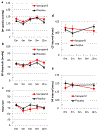Verapamil and beta cell function in adults with recent-onset type 1 diabetes
- PMID: 29988125
- PMCID: PMC6092963
- DOI: 10.1038/s41591-018-0089-4
Verapamil and beta cell function in adults with recent-onset type 1 diabetes
Abstract
Pancreatic beta cell loss is a key factor in the pathogenesis of type 1 diabetes (T1D), but therapies to halt this process are lacking. We previously reported that the approved antihypertensive calcium-channel blocker verapamil, by decreasing the expression of thioredoxin-interacting protein, promotes the survival of insulin-producing beta cells and reverses diabetes in mouse models1. To translate these findings into humans, we conducted a randomized double-blind placebo-controlled phase 2 clinical trial ( NCT02372253 ) to assess the efficacy and safety of oral verapamil added for 12 months to a standard insulin regimen in adult subjects with recent-onset T1D. Verapamil treatment, compared with placebo was well tolerated and associated with an improved mixed-meal-stimulated C-peptide area under the curve, a measure of endogenous beta cell function, at 3 and 12 months (prespecified primary endpoint), as well as with a lower increase in insulin requirements, fewer hypoglycemic events and on-target glycemic control (secondary endpoints). Thus, addition of once-daily oral verapamil may be a safe and effective novel approach to promote endogenous beta cell function and reduce insulin requirements and hypoglycemic episodes in adult individuals with recent-onset T1D.
Conflict of interest statement
COMPETING FINANCIAL INTERESTS STATEMENT
None of the authors have any interests to declare.
Figures




Comment in
-
Beta cell preservation in patients with type 1 diabetes.Nat Med. 2018 Aug;24(8):1089-1090. doi: 10.1038/s41591-018-0144-1. Nat Med. 2018. PMID: 30082859 No abstract available.
References
-
- Davis AK, et al. Prevalence of detectable C-Peptide according to age at diagnosis and duration of type 1 diabetes. Diabetes Care 38, 476–481 (2015). - PubMed
-
- Effect of intensive therapy on residual beta-cell function in patients with type 1 diabetes in the diabetes control and complications trial. A randomized, controlled trial. The Diabetes Control and Complications Trial Research Group. Ann Intern Med 128, 517–523 (1998). - PubMed
-
- Shalev A, et al. Oligonucleotide microarray analysis of intact human pancreatic islets: identification of glucose-responsive genes and a highly regulated TGFbeta signaling pathway. Endocrinology 143, 3695–3698 (2002). - PubMed
METHODS-ONLY REFERENCES
-
- Palmer JP, et al. C-peptide is the appropriate outcome measure for type 1 diabetes clinical trials to preserve beta-cell function: report of an ADA workshop, 21–22 October 2001. Diabetes 53, 250–264 (2004). - PubMed
Publication types
MeSH terms
Substances
Grants and funding
LinkOut - more resources
Full Text Sources
Other Literature Sources
Medical

